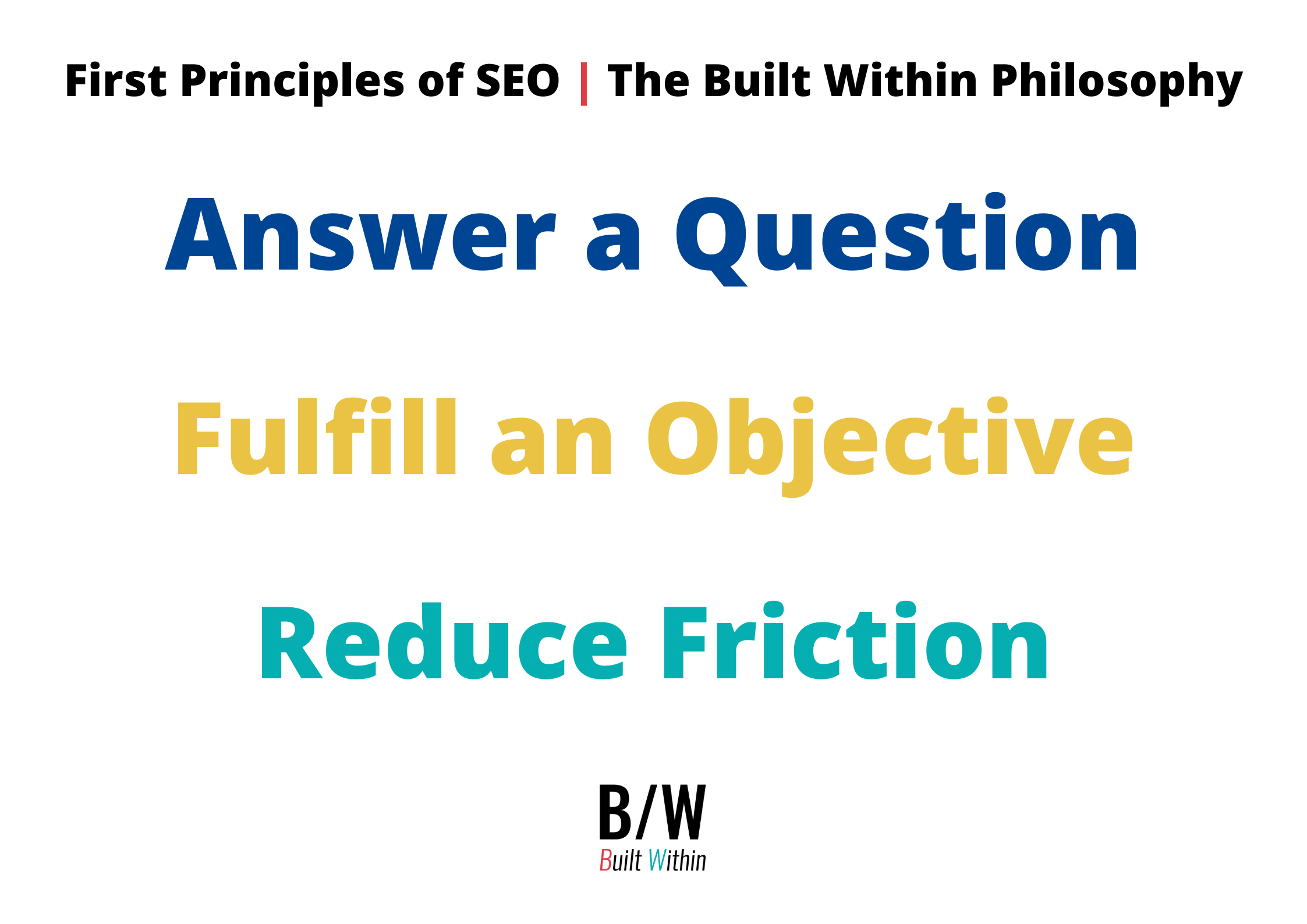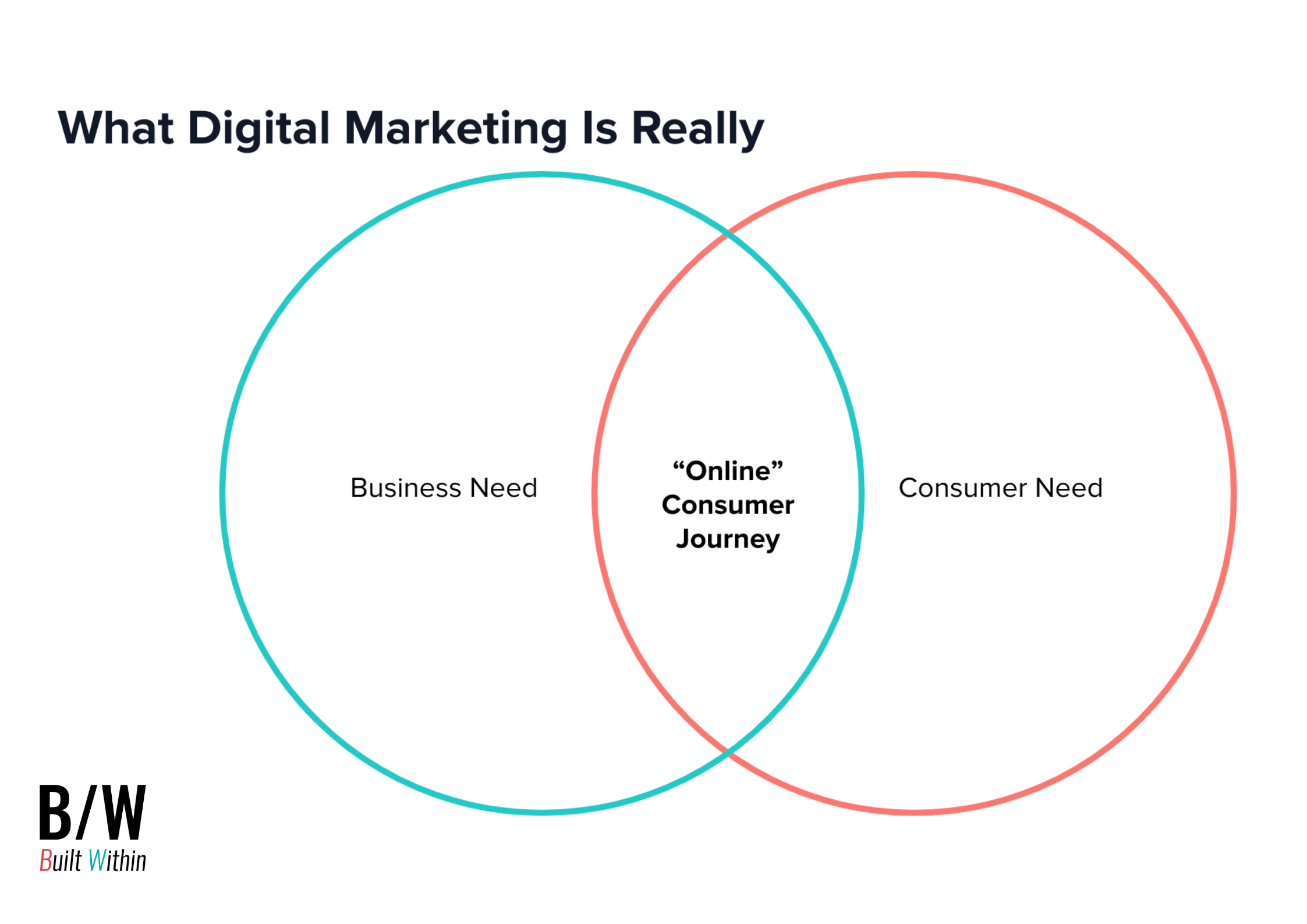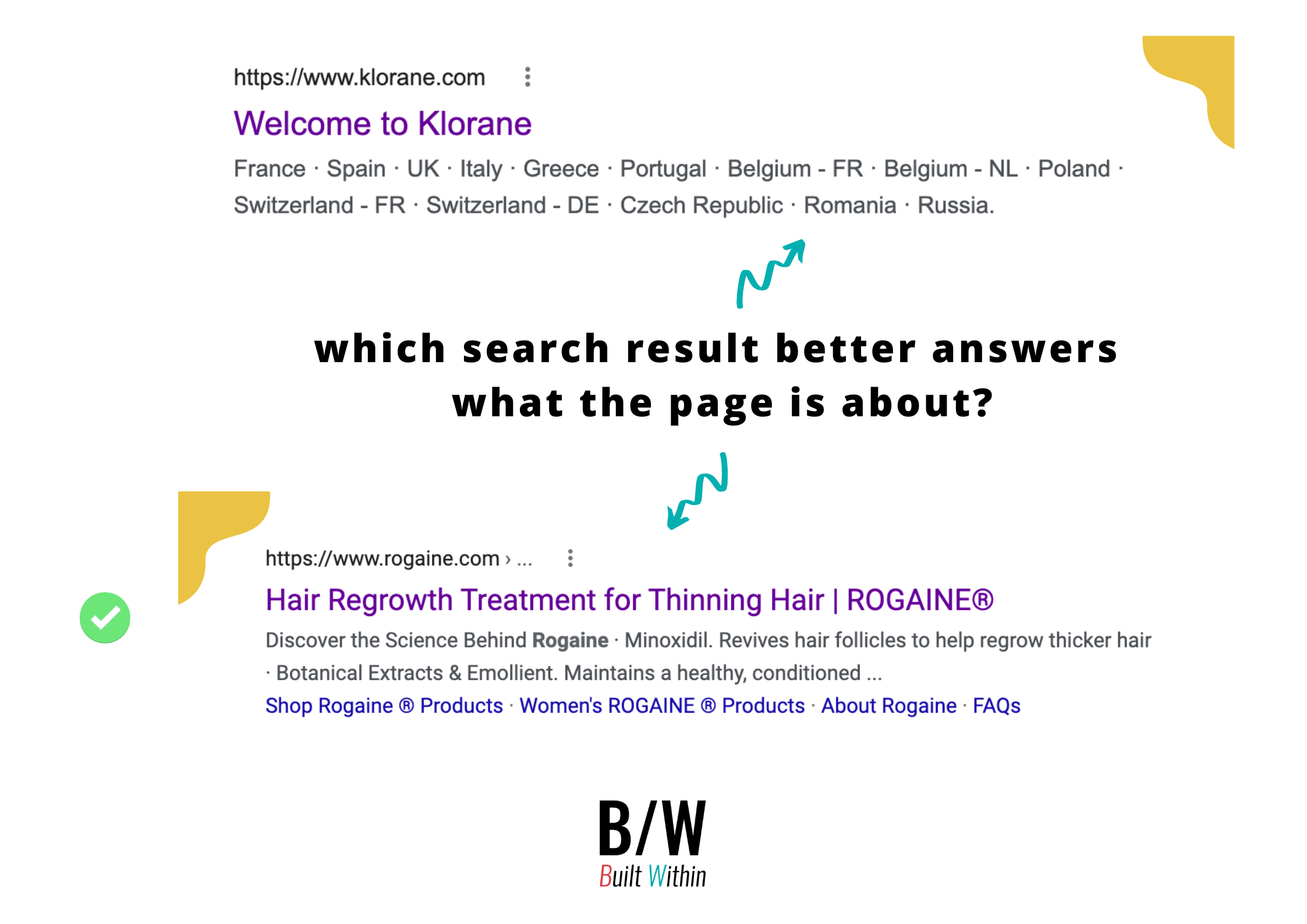First Principles of SEO | Foundations For Your SEO Strategy
The Built Within Philosophy
As business owners and consultants, building sustainable organic traffic to your website is hard - like annoyingly hard. Tasks that are buzzwords and normal to SEOs such as getting backlinks, creating E.A.T. content, tracking keywords, and just ensuring your website functions correctly, all can be like a second job taking away from you focusing on your core business.
Some of these tasks should be handled by an experienced SEO or developer, but what can make it difficult is when you also have to deal with shady marketers who promise things like instant traffic for $500. How do you know if these services are for real or if they’re just selling snake oil? And if they are charging these cheap prices for services, shouldn't you be able to figure it out on your own?
Yes, while search engine optimization can be complex, and in some cases requires technical expertise, there are fundamental truths to the space that a lot of business owners and marketers tend to overlook.
At Built Within, we've developed a First Principles outlook on developing one's organic search strategy and training businesses and consultants on how to execute their strategy. Once you understand this philosophy, organic search and your SEO strategy becomes a breeze and can be applied at all levels of your content and technical marketing.
The First Principles of SEO:
When it comes to foundational principles you need to know to be effective in SEO there are really only three:
If you can execute these principles with your website and its content, then you have the foundation you need towards achieving your SEO goals.
Let's go a little deeper into why each of these are so important.
ANSWER A QUESTION:
When you think about what Google's Mission is, it becomes obvious that Google is a place where you go to ask questions. That means your job, and the best way to rank, is to answer the questions your customers are searching for in ways that satisfy their needs. Super simple right?
We’re always looking for answers. "What is Abraham Lincoln's birthday?”, "Why does asparagus make my pee stink" (too much?)... Every page of your website needs to uniquely answer a question that your potential customer is looking for or something that they didn't even realize they were looking to be answered until they came to your web page or search result.
At Built Within we define digital marketing as the overlap between the consumer need and the business need. That overlap is the “online” consumer journey. Thus, digital marketing is the online consumer journey. In search - both paid and organic - the consumer is looking for an answer to a question. Your job is to provide that answer that fulfills the customers' needs. We’ll get to more on fulfilling needs in a bit with Principle Two.
Here’s an exercise we do in our bootcamps on day one of our 6-week course. You should try this for your website as well.
Open the homepage of your website and ask yourself:
What questions does this homepage answer?
Who does it answer it for?
Can the answer be more clear?
Is this answer for my consumer or me?
Pull up an index of all the pages Google currently has access to by typing: site:[insert url].com on Google.
Looking at your homepage result, if a potential customer were to read what it says would they:
Know the purpose of that page or what it is that your business does?
What about the other page results?
To avoid any bias, maybe have your friends do it and ask.
You're on solid ground if you provide clear answers, value, and maybe even some wit in your search results and content on-page. If not, then you now have some work to do. Because here's the thing, if your site's search results and content are unclear to humans, chances are it's also unclear to Google. This means crappy search results.
Key Takeaways and Extras
Every page of your website should answer a question
Write your content that speaks to your target audience, not a generic keyword target
If your title tag and meta description isn't clear to you, it isn't clear to Google
Learn how to optimize your title tags by using questions
FULFILL AN OBJECTIVE:
Once you make it clear how you bring potential value to your audience, you need to deliver on that promise. Fulfilling your consumers objective is simple - are you delivering on the promise you made to the consumer when they came to the site? And how are you keeping them engaged with that task?
We've all had that experience where you go to a website from a Google search expecting to solve some problem or fulfill some need. But for one reason or another, the site doesn't deliver on the expectations. Maybe the checkout process becomes unnecessarily complicated or unclear. The normal user behavior in this case is to bounce and go back to the search results, looking for better answers. In SEO this is called pogo-sticking - where a user goes to multiple results to satisfy their search intent.
Google says they do not use this metric as a ranking signal, so it may not directly affect where you "rank." Still, it does have an indirect impact on both results and the user experience, and every user who's not on your website is a user you potentially are missing out on converting.
REDUCE FRICTION:
The truth is, we live in an overstimulated world, where our attention is the currency. Social algorithms and our economic society's pace are designed to keep and distract your ability to focus. Users are conditioned to seek the experience that has the least resistance towards their goals. They always have options they can explore, not to mention that the increase in competition in almost all digital business segments has reduced consumer loyalty from where it was up until the late 2000s.
So what is friction in digital marketing? It's any factor in the digital consumer journey that prevents or slows the user from completing an objective. If consumers can't get their objective met quickly (a purchase, a download, or even a site load), the consumer is less likely to continue engaging with your website.
Most notably, in relationship to how it impacts search engine results, I'm speaking about page speed and site usability. Page speed 100% impacts your site's ability to rank on Google. Who says so, you might ask? Google says so. Core Web Vitals or CWVs are Google's focus on quantifying user experience based on several usability, speed, and design layout factors of a site. We talk more about CWVs and how they impact UX designers in an upcoming blog post. In short, if your site is slow, looks like it's from 2008, or is hard to navigate, you probably need to evaluate your site design.
So that’s it!
There are so many things you can do to increase your organic traffic. But before spending thousands of dollars on agencies, remember these three principles of answering a question, fulfilling an objective, and reducing friction. You'll have the opportunity to be competitive for many search terms in your space, garnering some sweet organic traffic.
Extra Tips To Consider When Applying These Principles:
How Should I Build My Website?
I get a lot of small businesses and solopreneurs asking me what platforms they should build their site on- WordPress, Squarespace, something custom etc.… And my answer is usually anything but Wix… Just kidding.
I usually try to communicate the importance of user experience and their abilities to maintain the site themselves vs. being dependent on a developer. In many cases, using Squarespace, or Shopify, which are making great strides towards their SEO, is a sufficient option to meet most businesses' needs. The usability of your website is key to turning over conversion rates.
Know Your Audience
Figure out what questions your customer is asking. For marketers, this involves a lot of interviews, keyword research etc. As a business owner, you should have keen insight into who is buying your product and for what reason. Trust that instinct and speak directly to that need in your marketing communications.
You can supplement this with technical research using tools like Semrush, Ahrefs, or even Clearscope. Knowing how to communicate to your potential consumer is also understanding their nuances; this is the key to creating a content marketing strategy that sticks. Social media is also a great tool to utilize for research here.
Cornerstone Content
Cornerstone Content or your Pillar Page is a page that speaks directly and in-depth about what your business does. This content should be answering the questions that show your unique value and is a great follow up from your mission statement or about us page, which are super important.
This page is also the page that you can use as an opportunity to link out to other content on your site, and really should be the page you spend the most time trying to rank on Google. Blogging and internal link building are very important parts of online marketing. When you know your audience it becomes clearer what type of content to create, which in turn is part of SEO best practices.
Sign up to our newsletter in the footer below to be the first to know when we drop our SEO Tips for a Mission Statement.
SUMMARY
I hope this was helpful and you can see the value of applying the First Principles. At Built Within we work directly with businesses and consultants to execute and practice these methods. Lots of people are looking for a high-quality certification in SEO. There's no real value in them because space is changing all the time. That said, what may be valuable to you is the opportunity to work on your business alongside an expert; while being trained so you can do it yourself.
We offer a 6-week Bootcamp where we go deep on these First Principles listed above; working on your own business and digital marketing strategy, LIVE. We give you personal support as you grow your business's traffic. Consider it like hiring an agency/consultant and getting job training at the same time. We believe in teaching people how to fish vs. just fishing for them.
If you're interested, you can learn more. If you aren't ready right now, sign up to our list where we drop tons of resources, like templates, webinars and videos, to support you on your journey. Check it out in our footer.




